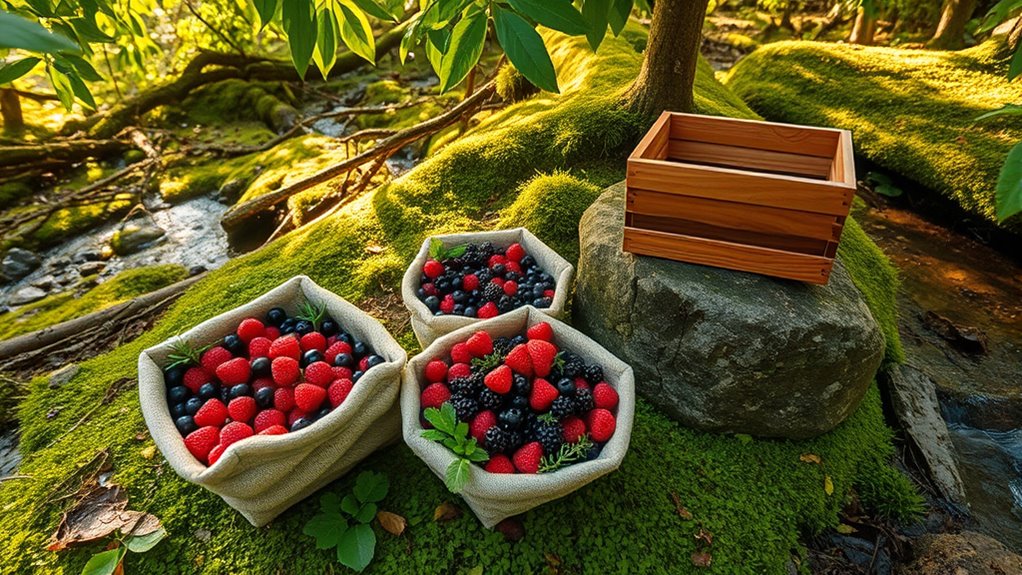To keep wild foods fresh from field to feast, use biodegradable containers and insulated coolers to prevent contamination and odors. Pack delicate items with moisture-resistant wraps and larger cuts double-wrapped in breathable materials. Keep everything chilled with ice packs or frozen water bottles, and store in shaded areas or vehicle coolers. Regularly monitor temperatures below 40°F and transport promptly to minimize spoilage. For more sustainable tips and effective strategies, continue exploring these essential transport hacks.
Key Takeaways
- Use insulated coolers with tight-fitting lids and pack with ice packs or frozen water bottles to maintain below 40°F during transport.
- Wrap delicate wild foods in moisture-resistant or breathable materials to prevent spoilage and contamination.
- Store containers in shaded areas or inside vehicle coolers to protect from direct sunlight and heat exposure.
- Minimize transport time by planning routes and handling to quickly transfer wild foods into refrigeration upon arrival.
- Choose eco-friendly, biodegradable, or reusable packaging to reduce waste and support sustainable practices during transport.

Transporting wild foods safely requires more than just tossing them into a bag. To guarantee your harvest stays fresh and safe for consumption, you need to pay attention to proper packaging and temperature management. Sustainable packaging plays a key role here, not only because it’s eco-friendly, but also because it helps maintain the integrity of the wild foods during transit. Opt for biodegradable containers, reusable coolers, or insulated bags made from natural materials that won’t compromise the quality of your catch. These options reduce waste and prevent contamination, offering a reliable way to protect your wild foods from dirt, pests, and moisture.
Temperature control techniques are equally important. Wild foods, especially game, berries, or mushrooms, are highly perishable and can spoil quickly if not kept at the right temperature. Use ice packs, gel coolers, or frozen water bottles to keep your haul chilled. Place them directly around the items or in compartments designed for temperature regulation. When transporting larger quantities, consider using insulated boxes or coolers with tight-fitting lids to lock in cold air. It’s vital to monitor the temperature regularly, using a small thermometer if possible, to make sure it stays within safe limits—generally below 40°F (4°C) for most wild foods. This prevents bacterial growth and preserves flavor, texture, and nutritional value.
Another tip is to avoid overpacking your containers. Leaving some space allows cold air to circulate and keeps everything evenly cooled. Wrap delicate items like berries or mushrooms in moisture-resistant paper or cloth before placing them in the cooler, preventing them from becoming mushy or moldy. For game or larger cuts of meat, double-wrap with breathable packaging to prevent leaks and reduce odor transfer. Keeping wild foods out of direct sunlight during transport is also essential—store your containers in shaded areas or inside a vehicle’s cooler compartment. When possible, plan your trip so you can get your wild foods into refrigeration or a cooler as soon as you arrive home. This minimizes the risk of spoilage and guarantees your wild foods remain safe and delicious. Additionally, choosing packaging that minimizes material waste supports sustainable practices and helps protect the environment.
Frequently Asked Questions
How Can I Prevent Contamination During Wild Food Transport?
To prevent contamination during wild food transport, you should prioritize sanitation practices. Clean all containers and surfaces thoroughly before use, and keep wild foods separate from other items to avoid cross-contamination. Use food-grade packaging and keep wild foods cool to inhibit bacterial growth. Regularly check for signs of spoilage, and handle everything with clean hands or gloves. These steps help guarantee contamination prevention and keep your wild foods safe for consumption.
What Are Eco-Friendly Packaging Options for Wild Foods?
Imagine saving the planet with every wild food transport! You can choose eco-friendly packaging options like biodegradable containers that vanish into the earth or reusable wraps that turn into treasure chests for future feasts. These sustainable choices cut down waste and protect nature’s bounty. So, next time, pack your wild foods smartly with eco-conscious gear, making every trip a step toward a greener, healthier world!
How Do I Handle Fragile or Delicate Wild Edibles Safely?
When handling fragile or delicate wild edibles, you need to prioritize safe transport to prevent damage. Use padded containers or wrap items in soft materials like cloth or bubble wrap to protect them during edible transport. Handle delicate wild food safety carefully, avoiding crushing or crushing. Keep them cool and stable, and pack them gently to maintain freshness. Proper handling ensures your wild foods stay pristine and safe from spoilage or damage.
Can I Transport Wild Foods Overnight Without Refrigeration?
Wondering if wild food storage overnight without refrigeration is possible? You can absolutely transport wild foods safely overnight by employing simple strategies. Use coolers with ice packs to maintain low temperatures, pack fragile foods carefully to prevent damage, and keep foods in airtight containers to avoid contamination. Prioritize transport safety by minimizing exposure to heat and direct sunlight. With these tips, your wild foods stay fresh and safe until you reach your feast!
What Legal Considerations Should I Keep in Mind When Transporting Wild Foods?
When transporting wild foods, you should be aware of wild food regulations to avoid legal trouble. Check if permits or documentation are required for harvesting or carrying certain species, especially protected or endangered ones. Always carry any necessary permits, and stay informed about local laws to guarantee you’re compliant. Following these guidelines helps you enjoy your wild harvest responsibly and legally, preventing fines or confiscation.
Conclusion
Think of transporting wild foods like tending a delicate garden. Handle each item with care, shielding it from harsh winds and scorching sun, just as you would protect fragile blooms. By following these hacks, you’re nurturing your wild harvest, ensuring it reaches your table as vibrant and fresh as when it was gathered. With patience and attention, your journey transforms into a smooth voyage, turning wild foods into a safe, nourishing feast—like a well-tended garden blooming beautifully.










